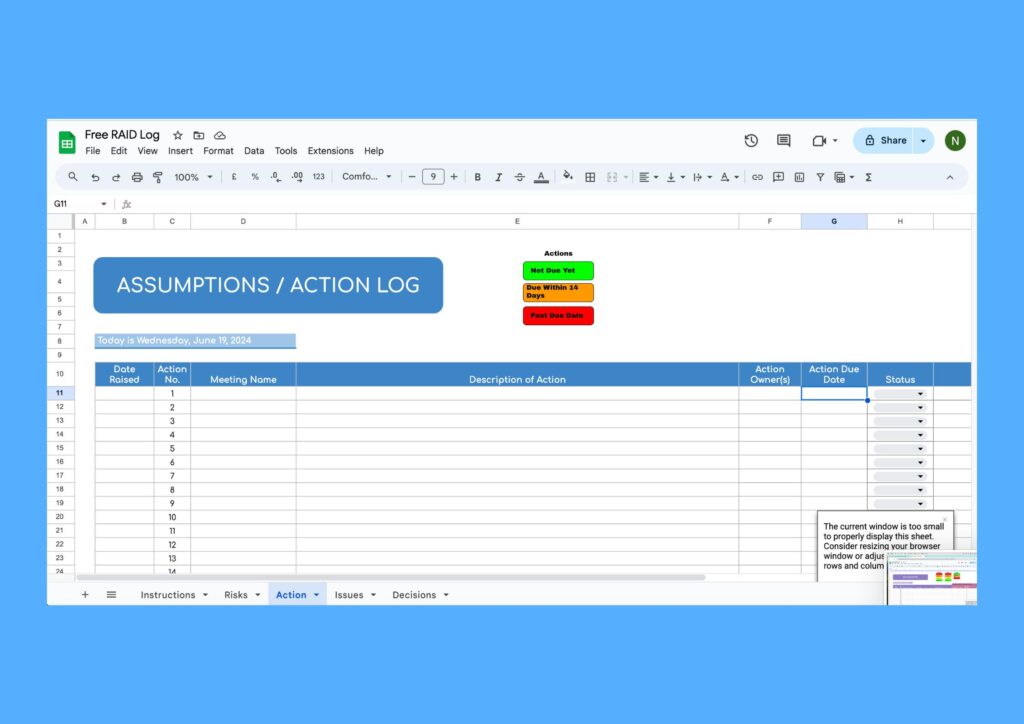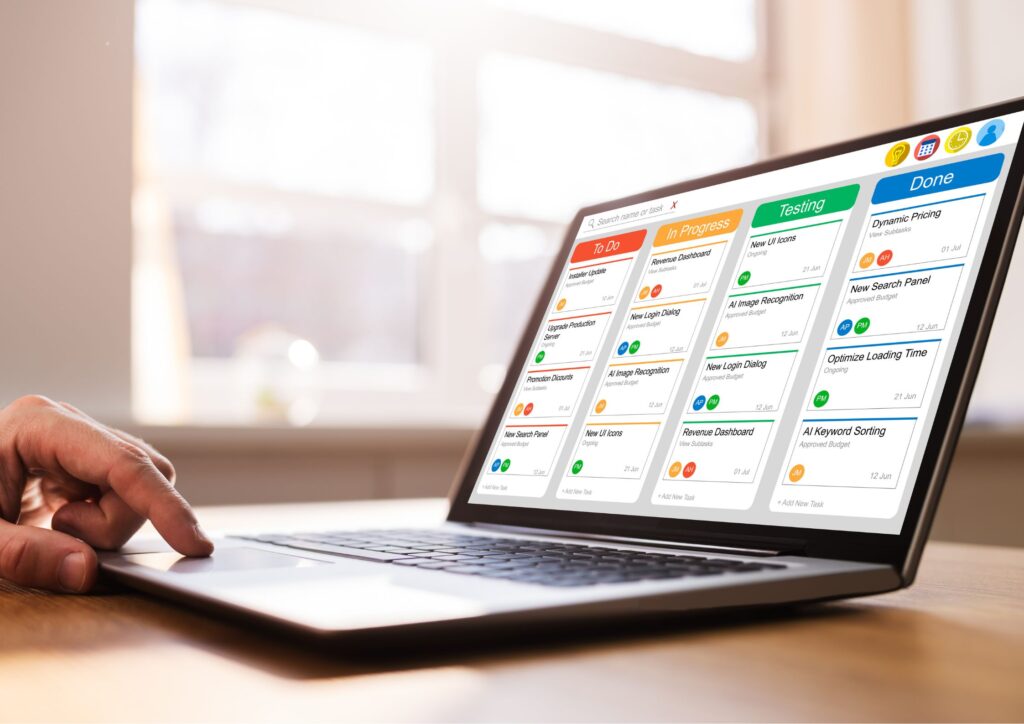Updated July 2024
In the fast-paced world of project management, having a reliable system to track risks, actions, issues, and decisions is paramount. Enter the RAID log – an essential tool that not only helps in planning and execution but also in steering projects towards successful completion.
This comprehensive guide will walk you through what a RAID log is, why it’s crucial for your business, and how to use it effectively.
Table of Contents
Introduction
What is a RAID Log?
A RAID log stands for Risks, Actions, Issues, and Decisions. It’s a project management tool designed to help project managers and teams keep track of these critical components throughout the lifecycle of a project. Here’s a quick breakdown:
- Risks: Potential problems that might affect the project.
- Actions: Tasks that need to be completed to keep the project on track.
- Issues: Problems that have already occurred and need resolution.
- Decisions: Key choices made during the project that could impact its direction.
Why is a RAID Log Necessary for Project Success?
A RAID log is essential for several reasons:
- Enhanced Organization: It keeps all critical information in one place, making it easy to access and review.
- Risk Management: By identifying and tracking risks, you can proactively mitigate potential problems before they become major issues.
- Accountability: Assigning actions and tracking their progress ensures that everyone knows their responsibilities and deadlines.
- Transparency: It provides a clear record of issues and decisions, fostering open communication and trust within the team.
Strategic Planning: Helps in making informed decisions based on documented risks, issues, and past actions.

How to Use a RAID Log Effectively
1. Setting Up Your RAID Log
Start by creating a RAID log template, which can be a simple spreadsheet or a more sophisticated project management software like Asana, Trello, or Microsoft Project. Your template should have separate sections or tabs for each component: Risks, Actions, Issues, and Decisions.
2. Populating the RAID Log
Risks: Begin by brainstorming potential risks with your team. Document each risk with a description, potential impact, likelihood of occurrence, and a mitigation plan.

Actions: List out all the actions required to move the project forward. Include details such as the action description, assigned person, due date, and current status.

Issues: Record any problems that have arisen. Each issue should have a description, impact on the project, a resolution plan, and an owner responsible for resolving it.

Decisions: Document all key decisions made during the project. Note the decision details, who made it, the date, and any implications it may have.

3. Integrating the RAID Log into Meetings
To maximize the effectiveness of your RAID log, incorporate it into your regular meetings. Here’s how:
Kick-off Meetings: Introduce the RAID log at the start of the project. Explain its purpose and how it will be used. Ensure everyone understands their role in maintaining it.
Regular Updates: Review the RAID log during weekly or bi-weekly team meetings. Update the status of actions, discuss new risks or issues, and record any decisions made.
Board Meetings: Use the RAID log to provide a concise update to stakeholders. Highlight major risks, significant issues, and important decisions. This keeps the board informed and aligned with the project’s progress.
4. Best Practices for Maintaining a RAID Log
- Consistency: Regularly update the RAID log to ensure it reflects the current state of the project.
- Collaboration: Encourage team members to contribute to the RAID log. This fosters ownership and ensures comprehensive coverage.
- Prioritization: Focus on high-impact risks and issues. Not all entries will be critical, so prioritize those that require immediate attention.
- Clarity: Use clear and concise language. The RAID log should be easily understood by all stakeholders, regardless of their familiarity with the project.
5. Real-World Example
Let’s consider a hypothetical software development project.
Risks: A potential risk might be the delay in receiving critical third-party API updates. Mitigation could involve planning for alternative solutions or setting up regular check-ins with the API provider.
Actions: An action item could be completing the user interface design by the end of the month. The design lead is assigned this task, with weekly check-ins to monitor progress.
Issues: An issue might be a bug discovered in the beta version that impacts the user experience. The development team needs to address this with a patch, and the issue is logged with its status and resolution steps.
Decisions: A key decision could be choosing between two different database management systems. After evaluating performance metrics, the team decides on the one that best meets their scalability needs.
Conclusion
A RAID log is more than just a documentation tool; it’s a strategic asset for project managers and teams. By systematically tracking risks, actions, issues, and decisions, you can navigate complexities with greater confidence and ensure your projects are on a path to success.
Implementing a RAID log not only enhances organization and accountability but also empowers you to manage risks proactively and make informed decisions. So, whether you’re planning a small project or leading a large-scale initiative, make the RAID log your go-to tool for seamless project management and career growth.
By following this guide, you’ll be well-equipped to utilize the RAID log effectively, ensuring your projects are thorough, well-planned, and set up for success. Happy project managing!
Written by

Located in Lancashire, England, Nayla is the founder and Project Manager of Transformation PM, a consultancy dedicated to helping businesses and project managers transition projects from concept to successful delivery. With a focus on efficiency and effectiveness, Transformation PM is a beacon of innovation in project management.
With a decade of experience in product management and eleven years in supply chain and inventory management, Nayla has expertise in aerospace, pharmaceuticals, retail, and the public sector. She has a proven track record of implementing transformational changes, sustainable pharmaceutical packaging, and innovative retail products.
Before founding Transformation PM, Nayla contributed to numerous high-profile projects. She holds a BA (Hons) in International Business and Marketing, is PRINCE2 Practitioner certified, and is pursuing PRINCE2 Agile certification.
Nayla's hands-on approach simplifies workplace bureaucracy and breaks down complex processes, making projects easier to complete. She is passionate about empowering teams and streamlining workflows to drive success and innovation.

- Click and edit anything
- Customise to match your branding
- Share and present
You might also be interested in

Add Your Heading Text Here
Lorem ipsum dolor sit amet, consectetur adipiscing elit. Ut elit tellus, luctus nec ullamcorper mattis, pulvinar dapibus leo.
Read more >

Add Your Heading Text Here
Lorem ipsum dolor sit amet, consectetur adipiscing elit. Ut elit tellus, luctus nec ullamcorper mattis, pulvinar dapibus leo.
Read more >

Add Your Heading Text Here
Lorem ipsum dolor sit amet, consectetur adipiscing elit. Ut elit tellus, luctus nec ullamcorper mattis, pulvinar dapibus leo.
Read more >

Add Your Heading Text Here
Lorem ipsum dolor sit amet, consectetur adipiscing elit. Ut elit tellus, luctus nec ullamcorper mattis, pulvinar dapibus leo.
Read more >

Add Your Heading Text Here
Lorem ipsum dolor sit amet, consectetur adipiscing elit. Ut elit tellus, luctus nec ullamcorper mattis, pulvinar dapibus leo.
Read more >

Add Your Heading Text Here
Lorem ipsum dolor sit amet, consectetur adipiscing elit. Ut elit tellus, luctus nec ullamcorper mattis, pulvinar dapibus leo.
Read more >

BOOST YOUR PROJECT SUCCESS WITH OUR FREE RAID LOG
Our RAID Log Template is designed to help you effectively manage risks, assumptions, issues, and dependencies, ensuring no detail is overlooked. You will receive; Risk Register, Assumptions (Actions) log, Issue log, Decision (Dependency) log. Increase team collaboration and share your RAID log seamlessly with your team, fostering communication and transparency.
© TRANSFORMATION PM | PRIVACY POLICY | TERMS AND CONDITIONS

